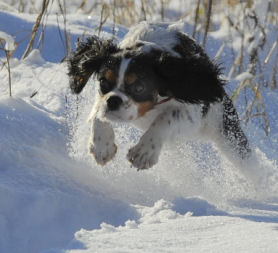UK snow: severe weather warnings for cold snap
As Britain is hit by fresh snowfall and severe weather warnings are put in place across the UK, Science Correspondent Tom Clarke looks at the links between the Eastern Pacific and our cold weather.
Temperatures plummeted below zero last night, with the North East, Yorkshire and Humber, East Midlands, the South West and Scotland all set for heavy snow, as the cold weather spreads southwards. The Met Office is also warning of widespread icy roads across much of the country.
One of the coldest places overnight was Trawscoed in Wales with temperatures of minus 10.2C.
The biting weather has also forced several football matches and race meetings to be postponed this weekend, as around 25cm (10ins) of snow expected on higher ground today.
The big freeze is also set to cover swathes of the country in white by the middle of next week, according to forecasters.
As snow covers the UK Channel 4 News asks if councils have enough grit. Read more: Where is the grit?

The South West will see the warmest temperatures today, rising to around 3C, but in other areas the temperatures will struggle to reach zero.
Up to 30cm of snow fell in the Highlands of Scotland and North Yorkshire yesterday, with snow also drifting across Wales and the South West. It is the earliest widespread snowfall in the UK for 17 years.
The AA said it was called to 16,000 breakdowns yesterday, with 1,220 calls every hour at peak times.
Last night the M4 westbound in south Wales saw a 26-mile traffic jam as a result of the weather, with the M25 and the M40 also hit.
The unusual weather has been caused by high pressure over Greenland and low pressure in the Baltics, forcing cold winds from the north east across Europe.
La Nina phenomenon
What does last night's snow in Tyneside have in common with rain in San Francisco? A weather phenomenon called La Nina, according to some meteorological experts, writes Science Correspondent Tom Clarke.
A few key climate patterns or "oscillations" can have knock-on effects around the world - none more so than the El Nino/La Nina phenomenon in the Eastern Pacific. In an El Nino year the temperature of the eastern pacific rises, which in turn warms the atmosphere. This can cause serious droughts in the Western US and South America and can have impacts as away as Australia.
La Nina is the direct opposite and right now we're in a strong La Nina phase. The Eastern Pacific is more than two degrees cooler than normal and US experts are predicting a La Nina of record-breaking strength. This can cause much wetter conditions in the Western US but possible droughts in the Mid-West. The effects of La Nina can displace other weather patterns that in turn impact us. "As a rule of thumb it's accepted that a La Nina in the Pacific can lead to a cold start to the winter in Europe," says Barry Grommet with the Met Office in Exeter.
But the Pacific only deserves part of the blame for the severe weather. The jet stream, which normally helps keep British weather mild and damp isn't quite as it should be. This as high altitude air current carries warmer moist air from West to East across the Atlantic. But right now there is a kink in it. Much of its warmer moister air is flowing to the south of the UK leaving us at the mercy of arctic winds blowing from the North and North East.
According to forecasters this frigid air alone isn't responsible for the snow. Our warm(ish) oceans play a big part too. Sea temperatures around Britain are around 10 degrees centigrade right now. As the cold arctic winds pass over, they give up their moisture to the air. But when the winds hit the land - which remember is 10 to 20 degrees colder than the sea right now - that moisture freezes out and falls as snow.
As winds move round from the northeast, so to too will the snow. It's expected southern counties will get flurries this evening, particularly the Isle of White with the rest of the Southeast seeing snow by Tuesday.
Mongolia snow
But while the UK shivers, parts of China’s Inner Mongolia Autonomous Region have been hit by the words blizzard in 30 years, with snow as deep as 1 meter in some areas.
The 50,000 residents of administrative district Hinggan League have seen more than 660,000 hectares of grassland damaged and over 750 livestock killed.